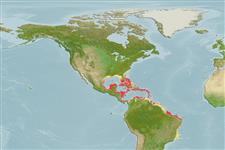>
Eupercaria/misc (Various families in series Eupercaria) >
Scaridae (Parrotfishes) > Sparisomatinae
Etymology: Sparisoma: Latin, sparus = a fish with a golden head + Greek, soma = body (Ref. 45335).
More on author: Bonnaterre.
Environment: milieu / climate zone / depth range / distribution range
экология
морской ассоциированный с рифами; пределы глубины 3 - 50 m (Ref. 9710). Subtropical; 34°N - 21°S, 98°W - 28°W (Ref. 55284)
Western Atlantic: southern Florida (USA), Bermuda, Bahamas, and throughout the Caribbean Sea to Brazil.
Length at first maturity / Size / Вес / Возраст
Maturity: Lm 16.3, range 18 - ? cm
Max length : 64.0 cm TL самец/пол неопределен; (Ref. 3802); common length : 38.0 cm TL самец/пол неопределен; (Ref. 3802); наибольший вес (опубликованные данные): 1.6 kg (Ref. 26340)
колючие лучи спинного плавника (общее число) : 9; членистые (мягкие) лучи спинного плавника (общее число) : 10; колючие лучи анального плавника: 3; членистые (мягкие) лучи анального плавника: 9. Relationship between fork length (FL) and maximum body depth (D): D = 0.10 + 0.33(FL); FL = -0.40 + 3.06(D), for n = 79, length range (cm, FL) = 13.5-25.5 (Ref. 3191). A distinctive, colorful and abundant fish. Young adults and females with scales outlined in darker gray; often bright red below. Super males green, with bright yellow spot at upper edge of gill cover, yellow bar at base of tail, curved orange-yellow mark on caudal fin rays (Ref. 26938). Initial phase fish with a brown head, the scales of the upper two-thirds of the body with pale centers and dark brown edges, the lower third of body and fins bright red. Terminal phase males are green with three diagonal orange bands on upper half of head
Inhabits coral reefs with clear water (Ref. 13628). Young may be found in seagrass beds and other heavily vegetated bottoms. Feeds mainly on soft algae, but has been observed to graze on live corals like, Montastraea annularis (Ref. 6496). Produces a significant amount of sediment through bioerosion using its strong beak-like jaws and constantly re-growing teeth (Ref. 6485). Protogynous; strictly diurnal, spends the night sleeping on the bottom (Ref. 5221). Found singly or small in small groups.
Life cycle and mating behavior
Maturities | размножение | Spawnings | Egg(s) | Fecundities | личинки
The type of reproductive behavior is related to the color phase of the males involved.
Cervigón, F., R. Cipriani, W. Fischer, L. Garibaldi, M. Hendrickx, A.J. Lemus, R. Márquez, J.M. Poutiers, G. Robaina and B. Rodriguez, 1992. Fichas FAO de identificación de especies para los fines de la pesca. Guía de campo de las especies comerciales marinas y de aquas salobres de la costa septentrional de Sur América. FAO, Rome. 513 p. Preparado con el financiamento de la Comisión de Comunidades Europeas y de NORAD. (Ref. 5217)
Статус Красного Списка МСОП (Ref. 130435)
Угроза для людей
Reports of ciguatera poisoning (Ref. 30303)
Использование человеком
рыболовство: не имеет хозяйственного значения; аквариум: коммерческий
дополнительная информация
инструменты
Специальные отчеты
Скачать в формате XML
ресурсы в Интернет
Estimates based on models
Preferred temperature (Ref.
123201): 25.4 - 28, mean 27.2 °C (based on 206 cells).
Phylogenetic diversity index (Ref.
82804): PD
50 = 0.5000 [Uniqueness, from 0.5 = low to 2.0 = high].
Bayesian length-weight: a=0.01380 (0.00901 - 0.02115), b=3.05 (2.93 - 3.17), in cm total length, based on LWR estimates for this species & Genus-body shape (Ref.
93245).
Trophic level (Ref.
69278): 2.0 ±0.00 se; based on food items.
Generation time: 2.4 ( na - na) years. Estimated as median ln(3)/K based on 2
growth studies.
устойчивость к внешним воздействиям (Ref.
120179): средний (среднего размера), минимальное время удвоения популяции 1.4-4.4 года (tmax=9; k >0.30).
Prior r = 1.04, 95% CL = 0.68 - 1.56, Based on 1 data-limited stock assessment.
Fishing Vulnerability (Ref.
59153): Low to moderate vulnerability (31 of 100).
Nutrients (Ref.
124155): Calcium = 23.5 [12.5, 48.3] mg/100g; Iron = 0.649 [0.330, 1.159] mg/100g; Protein = 19.1 [17.0, 21.5] %; Omega3 = 0.152 [0.082, 0.269] g/100g; Selenium = 19 [9, 40] μg/100g; VitaminA = 21.8 [5.8, 80.5] μg/100g; Zinc = 0.943 [0.615, 1.606] mg/100g (wet weight);
